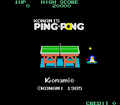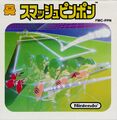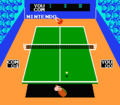
| Konami's Ping Pong | |
|---|---|
| Developer(s) | Konami |
| Publisher(s) | Konami, Imagine |
| Year released | 1985 |
| System(s) | Amstrad CPC, Commodore 64/128, Arcade, Family Computer Disk System, MSX, Sinclair ZX Spectrum |
| Japanese title | コナミのピンポン |
|---|---|
| Genre(s) | Sports |
| Players | 1-2 |
| Modes | Single player, Multiplayer |
Konami's Ping Pong is an arcade game developed by Konami in 1985. It simulates the game of ping-pong or table tennis in a remarkably different manner than prior simulations of any variety of tennis. Rather than putting the emphasis on precise control and placement of the paddle in order to return the ball, the emphasis is on timing and strategic control of the ball's speed and trajectory. The player sees no other on-screen representation of themselves beyond a hand holding a paddle. The hand and the paddle automatically move left and right to match the horizontal position of the ball. Players need only concern themselves with the timing of their paddle swing, and the style of swing to use. Players can choose between three different swings, along with the choice of forehand or backhand. Pentarou, the penguin from Konami's Antarctic Adventure has a cameo throughout the game as Konami's mascot. He appears on the title screen, as well as among the crowd in the audience (left side).
-
Title screen
-
Screenshot
Controls[edit]
| Control | Volley | Serve |
|---|---|---|
| Drive | Move left | |
| Cut | Move right | |
| Smash | n/a | |
| Backhand | Toss ball up |
Gameplay[edit]
Service[edit]
- Move the paddle to the left or right with the joystick. Choose a position to serve from.
- Press the button to toss the ball up in the air.
- Time your service strike by pressing left or right to use a Drive swing or a Cut swing (a Smash swing is not permitted during a serve).
- You may, if you like, hold the button down to begin your serve with a backhand swing instead.
Note: Your paddle will automatically position itself when your opponent is serving.
Rules[edit]
- Games are played as a best of three. The game is concluded as soon as one player wins two games.
- For each game, the first player to reach 11 points wins the game.
- If the score becomes 10 to 10, play continues until one player gains a lead by two points (up to a maximum of 15 points).
- Alternation of service
- Service changes hands every 5 points. That is, the combined score of both players, not the current score of one player.
- When players are tied up after 10 to 10, service alternates after every single point.
- Alternation of court
- Players swap sides of the table after every game. (When playing a single player game against the computer, you will never swap sides.)
- During the third game, players swap sides of the table after every five points.
- Returning the ball
- The trajectory of the ball is determined by the time at which the paddle is swung.
- By quickly switching to a backhand swing, it is possible to return balls that would otherwise be missed by a forehand swing.
Technique[edit]
| Swing | Speed of ball | Rotation of ball | How to use |
|---|---|---|---|
| Smash | Fastest | Forward | A smash is best used to return a weak or slow volley by the opponent. If performed too soon, it can miss the table. If performed too late, it can hit the net. If performed well, it can be difficult to return. |
| Drive | Fast | Forward | This swing is a relatively safe return that keeps the ball speed high while allowing you to set up for an attack. |
| Cut | Slow | Backward | Using the cut swing will slow the ball speed down. Use this to slow down the pace of the game. While a patient player can easily return this type of return, an anxious player may swing his or her paddle too soon and miss. |
| Forehand or Backhand stroke |
n/a | n/a | Proper use of forehand and backhand swings is essential to controlling the direction of the ball across the table. It is important to control the ball in order to keep it on the table, but you can also take your opponent by surprise by sending the ball to the player's weak side. |
Terms[edit]
- IN: The ball hit the table and the opponent failed to properly return the ball.
- OUT: The last player to hit the ball failed to properly hit the opponent's side of the table.
- NET: The ball hit the net. When serving, the serve is taken over.
- LET: No points are awarded.
- DEUCE: When both players are tied up at 10 to 10, and one player must beat the other by two points to win.
- LOVE ALL: The start of the game, when both players have a score of 0.
- CHANGE COURT: Each player swaps sides of the table.
- GAME SET: The game is complete.
Ports[edit]
| Smash Ping Pong | |
|---|---|
| Developer | Konami |
| Publisher | Nintendo |
| Systems | Family Computer Disk System, Wii |
| Year released | FDS:1987 Wii:2008 |
Famicom Disk System[edit]
The Famicom Disk System conversion was developed by Konami, and published directly by Nintendo as Smash Ping Pong. As a result,Konami's penguin mascot Pentarou was replaced by Diskun, the Famicom Disk System mascot, on the title screen, and Donkey Kong Jr. appears in the stands on the right side. The conversion offers several variations of play, including one or two player games, plays to 11 or 21 points, and five levels of difficulty. Additionally, Deuce win conditions do not end at 15 points, but can climb as high as 99 points. The game was released for the Wii Virtual Console in Japan in 2008, and in Europe in 2009 as Smash Table Tennis.
-
Cover art
-
Title screen
-
Screenshot
Home computers[edit]
Konami developed and published the conversion for the MSX line of home computers. Imagine software developed and published a conversion of the game for several popular home computers in Europe.
-
MSX box
-
Commodore 64 box
-
Amstrad CPC box
-
Sinclair ZX Spectrum box
-
MSX screenshot
-
Commodore 64 screenshot











